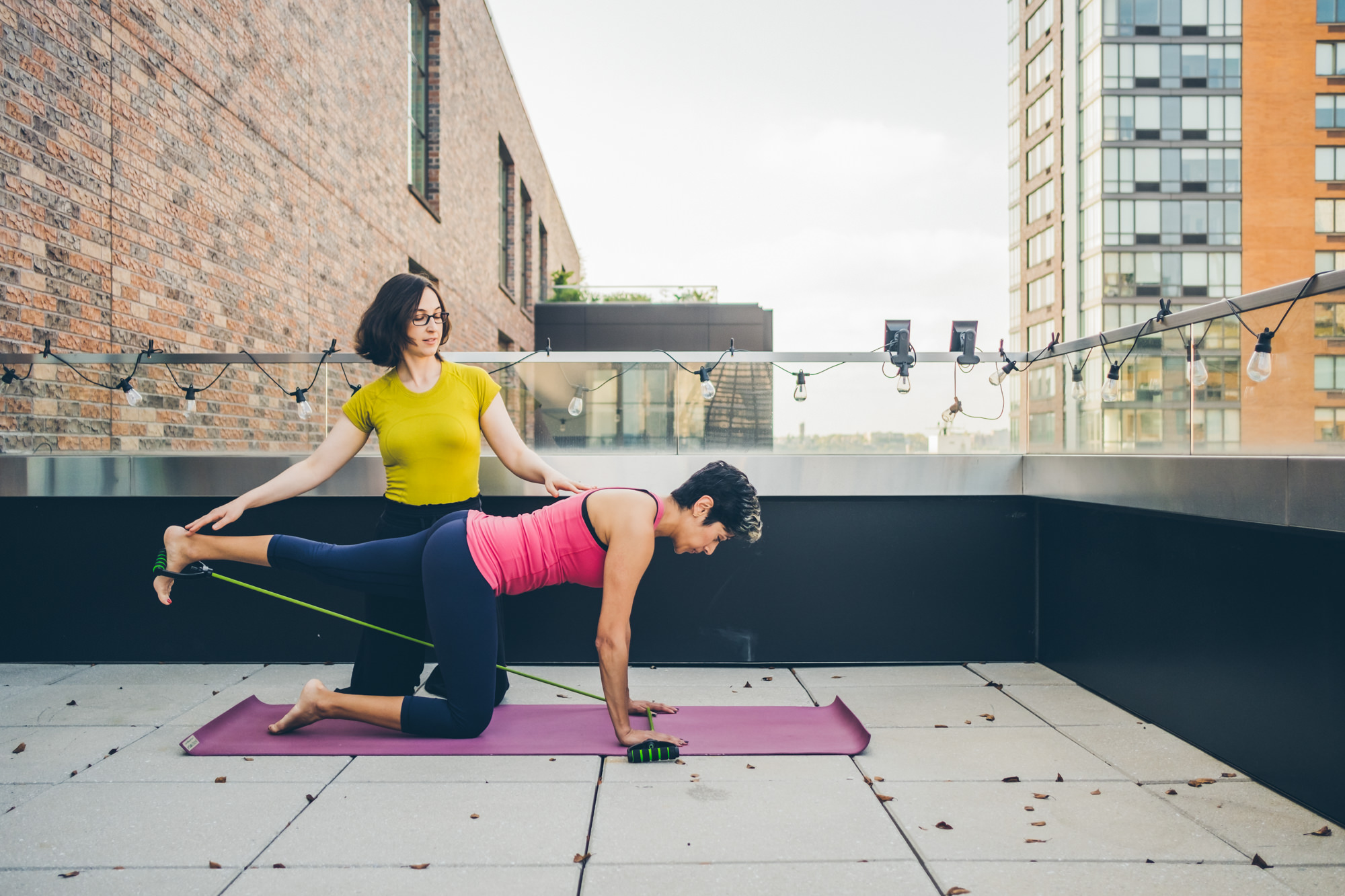Why exercise is a longterm investment

As an independent personal trainer, Pilates, and Yoga teacher my work is largely to help people learn how best to take care of their bodies through physical exercise, and breathing techniques. Over the years of working with people in this capacity I have noticed that many people seem frustrated by the fact that they have to keep up so much regular care and maintenance. They are annoyed when their body seemingly “fails” them by not always being ache free and perfectly functional. I often hear things such as, “I went to physical therapy, and it got better, but now it bothers me again.” The idea seems to be that all physical issues should be “fixable” and then easily ignored. My experience working with people is that it takes regular, committed, and focused attention to our bodies in order to maintain some semblance of functional movement as the decades continue on. In other words it takes an investment of your resources over a long period of time to work towards longevity and a continued rich quality of life.
The next time you feel frustrated that your body doesn’t run perfectly all the time pause for a moment and consider the following two things:
- Our bodies last a long time. Think about the life span of most other animals. While there are exceptions such as the Bowhead Whale which often lives about 200 years, elephants 60 years, and some species of Gorillas living for around 50 years, these examples are not the norm. Humans can live an unusually long time in comparison with other creatures.
- If you owned one house for your whole life, you would expect to have to clean, repair, and do other maintenance on the house. Why would you expect that your body wouldn’t also need regular upkeep and care?

If you want to feel good in your body, thereby being able to enjoy life with regular movement, travel, outdoor adventures, dancing, and just being relatively pain-free as the years go by, you need to think in terms of a committed, regular, sustainable, and enjoyable plan for body care.
A well-rounded program includes being aware of your posture, balance, bone density, muscle strength, heart health, joint health, diet, hydration, and mental well-being. It may seem like a lot to think of, but it is your body! However you treat it now, it will pay you back in the short and long-term.
Fortunately, what is good for one part is usually good for another. For example, strength training is good for your muscles, and your bones. Eating fiber is shown to not only improve digestion, but also help with weight management, and heart health. It is never too late to start as even small improvements can make a big difference to quality of life.
The beautiful thing about taking small steps towards a healthy lifestyle is that like any good investment, it grows on itself. When you do something simple, like going for a walk, you feel better, which enables you to have the energy to make a healthier dinner, which could mean a better nights sleep… and so the cycle continues, building on itself to make you feel and look your best.
Balance series for better walking
Do your summer goals, or life goals for that matter, include being able to go where you want feeling confident that your legs are underneath you, and will carry you as far as your heart desires? The following balance series, which can be done anywhere, may be what you’re looking for. *
This short series will help you get ready for your summer trips to far away cities, the mountains, or the beach. Often these fun trips involve a lot of walking on uneven ground, such as cobblestones, hills, rocks, or sand. Getting in shape for summer isn’t just about looking good in a swimsuit, it’s also about balance, and being able to walk with confidence on all the rough terrain you may be hoping to cover. Focusing on balance develops the strength to balance and walk with more ease, and as an added bonus it will tone the hips and engage the abdominals, giving you a more sleek look.
Important set-up: All exercises should be performed with a sturdy chair or wall within reach. You can choose to hold onto the chair/wall at any time during this series. Start with your feet parallel and hip-width distance apart. Repetitions range to accommodate all levels. Choose the level of repetitions where you feel the muscles activating, but not exhausted. Try the advanced options once the initial exercise becomes easy.
Practice every day for 5-10 minutes for best results
Heel raises
- Slowly rise onto the balls of your feet then slowly lower back onto your heels.
- Important cues: Think of your navel lifting up to the top of your head. Look straight ahead. Keep your knees straight.
- Repeat 10-30 times
- Advanced option: Try doing heel raises on one foot

Leg lifts to the back
- Slowly lift one leg behind you, then slowly lower the leg until your toe touches the ground.
- Important cues: Keep your foot flexed, and your knee straight. Pull your navel to your spine to support your lower back. Gently squeeze your glute as your leg goes behind you.
- Repeat 10-30 times on each leg

Leg lifts to the side
- Slowly lift one leg to the side, then slowly lower the leg back to the starting position.
- Important cues: Keep your foot flexed, and your knee straight. Pull your navel to your spine to support your lower back. Keep your hips even so as to activate the side hip muscles rather that the side waist muscles.
- Repeat 10-30 times on each leg
Standing on one foot
- Lift your knee up in front of you and hold the position.
- Important cues: Pull your naval to your spine. Keep your standing leg straight, but not locked out. Focus your gaze on something that is not moving.
- 10 seconds to a minute on each side
- Advanced option: progress to closing your eyes

Leg swings
- Standing on one leg swing the other leg loosely.
- Important cues: Focus on the leg you are standing on by gently tightening the glutes, and keeping the leg strong and straight. Pull your naval to your spine.
- Repeat 10-30 times on each leg

Heel to toe walk
- Walk as if on a tightrope, in one straight line, with your heel coming in front of your toes.
- Important cues: Look straight ahead rather than down at your feet. Pull your naval to your spine.
- Practice for 1-2 minutes.
- Advanced option: Try going backwards!
*As with any exercise routine, please consult your doctor before to make sure this is safe for you. If you experience pain, discontinue the practice.
Morgana Tessler is a Certified Orthopedic Personal Trainer, Yoga, Pilates, Meditation and Barre Instructor based in NYC. Morgana offers private and group fitness sessions. For more information visit www.morgana.nyc Facebook, Instagram
What Motivates a Fitness Professional?
 Sometimes people assume that because I am a personal trainer, yoga, pilates, meditation and barre instructor I am just inherently in good shape, eat healthfully and live life mindfully at all times. It would be wonderful if by teaching others to live healthfully I absorbed the benefits of a good diet, exercise and meditation routine by osmosis. But the truth is that I am just a person like anybody else, and I argue with myself about going to the gym, waking up early to meditate and whether or not to order dessert.
Sometimes people assume that because I am a personal trainer, yoga, pilates, meditation and barre instructor I am just inherently in good shape, eat healthfully and live life mindfully at all times. It would be wonderful if by teaching others to live healthfully I absorbed the benefits of a good diet, exercise and meditation routine by osmosis. But the truth is that I am just a person like anybody else, and I argue with myself about going to the gym, waking up early to meditate and whether or not to order dessert.
What hope is there if even a personal trainer has to struggle with living a healthy lifestyle? I am here to share with you what motivates me personally to live my life healthfully, and how I think it can help you too. It largely boils down to three key factors, education, community and being a role model.
Inspirational education: As a personal trainer I am constantly reading articles and studies about health and wellness so that I can be up to date on the latest research and be able to provide the best information to my clients and students. While my initial motivation for reading an article may be to educate my self as a professional, it also impacts the way I want to live my life. If I read the article How Exercise Could Lead to a Better Brain, I feel excited about my own workouts as well as my clients.  While I often dig deeper and try to read the studies behind whatever the latest trend may be, much of my research comes from easily accessible and fun to read sources such as the New York Times Well section, Yoga Journal, and even magazines like Shape or Self. There are a lot of studies being done on food, exercise, meditation, and how a healthy lifestyle impacts our whole lives. By reading a few articles a week and maybe sharing them with friends or family you think would be interested, you may find yourself more motivated and excited about making healthy changes in your life.
While I often dig deeper and try to read the studies behind whatever the latest trend may be, much of my research comes from easily accessible and fun to read sources such as the New York Times Well section, Yoga Journal, and even magazines like Shape or Self. There are a lot of studies being done on food, exercise, meditation, and how a healthy lifestyle impacts our whole lives. By reading a few articles a week and maybe sharing them with friends or family you think would be interested, you may find yourself more motivated and excited about making healthy changes in your life.
Community: When I am exercising, and I get to that part where I want to quit, I think of my clients and students. It is my goal to help people exercise safely past their comfort zone and to the point where changes happen in the body on all levels. I would feel embarrassed if I didn’t practice what I preach.
 When my alarm wakes me up at 5:30 am for 30 minutes of Pilate’s stability exercises before my day starts, I think of all the other people in gyms, or on yoga mats throughout the city who got up well before the break of dawn to do something good for themselves. I admit that it was a shock to me when I first learned that people went to the gym at 5 am in this crazy city that never sleeps. But I have since then come to feel inspired by it. On the other side, plenty of my clients and students are not morning people and they share stories about getting home late, and doing their exercises at midnight before falling asleep. My clients and students have taught me that there is always time to prioritize you’re health and that the impacts of making changes in your life does result in real, tangible and lasting changes. Seeing those changes occur in the people who trust and follow my guidance has in turn inspired me to live what I teach every day.
When my alarm wakes me up at 5:30 am for 30 minutes of Pilate’s stability exercises before my day starts, I think of all the other people in gyms, or on yoga mats throughout the city who got up well before the break of dawn to do something good for themselves. I admit that it was a shock to me when I first learned that people went to the gym at 5 am in this crazy city that never sleeps. But I have since then come to feel inspired by it. On the other side, plenty of my clients and students are not morning people and they share stories about getting home late, and doing their exercises at midnight before falling asleep. My clients and students have taught me that there is always time to prioritize you’re health and that the impacts of making changes in your life does result in real, tangible and lasting changes. Seeing those changes occur in the people who trust and follow my guidance has in turn inspired me to live what I teach every day.
How is this relevant to non fitness pros? I think the real key here is surrounding yourself with people who do the things you want to be doing. Every day I am talking to people who are dedicated to making at least a small commitment to their health and wellness, and this is something you can do without teaching exercise classes. How that looks for you could be very different from someone else. Try joining a walking group. Or start a walking group with some of your colleagues at work. Find a group fitness class where the teacher and students excite you. Hire a personal trainer who takes the time to work with your needs and goals. Take a healthy cooking class. Take a meditation class. The key is to find other like minded people who are working on living the lifestyle you are aspiring too. Social media can also be a great source of healthy-minded people. I love mynewroots.org, thechalkboardmag, ohsheglows, karlytreacy, and well.blog.nytimes. And of course you can follow me on Facebook, Instagram, and Twitter and sign up to receive my email updates.
Be a Role Model: It is my job to lead by example and to practice what I preach, which of course is a big motivation. Why not make it a goal to be an inspiration and example to others? I often see when a client or student of mine makes a big change in their life that it encourages others. Seeing is believing. Maybe you could give someone else courage to show up and try? This doesn’t mean being perfect or having already achieved certain goals. People are encouraged by other people who struggle, persevere and try their best.
What I’m really saying is that as a fitness professional, I am constantly surrounding myself with resources and a community of people who are trying to live healthier lifestyles and it is my job to motivate, educate and inspire them.  While health and wellness may not be your profession, I think that there is a lot that could be recreated by simply reading and sharing information, surrounding yourself with people who are trying to live a meaningful, joyful, and healthy lifestyle, and asking yourself to be the change you want to see.
While health and wellness may not be your profession, I think that there is a lot that could be recreated by simply reading and sharing information, surrounding yourself with people who are trying to live a meaningful, joyful, and healthy lifestyle, and asking yourself to be the change you want to see.
Morgana Tessler is a Certified Orthopedic Personal Trainer, Yoga, Pilates, Meditation and Barre Instructor based in NYC. Morgana offers private and group fitness sessions. For more information visit www.morgana.nyc Facebook, Instagram
Gentle Yoga Post-Feast
Indulging in a delicious meal with family and friends is one of the great joys of the holiday season. Starting with the Thanksgiving feast and going all through the holiday season, it can be a time of enthusiastic eating and drinking. While this is often a pleasure and something many people look forward to all year, sometimes it can be too much for the digestive system and we wind up feeling bloated, and uneasy in the stomach.
Here is a short easy series of yoga poses to help relieve digestive discomfort post-feast. These yoga poses were selected to help massage your internal organs that are associated with the digestive tract. By stimulating the digestive muscles you increase blood flow and movement through your body and help to reduce discomfort and restore energy.
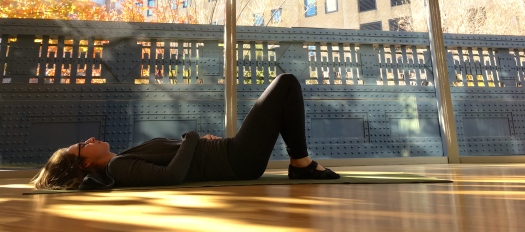
Begin by laying on your back with your knees bent, and feet on the floor. Place your hands onto your abdomen and feel your breath slowly rise and fall. Breathe slowly for a minimum of 1 minute, or as long as it feels comfortable. Slow, calm breathing allows your body to relax and get to work on digesting all that food.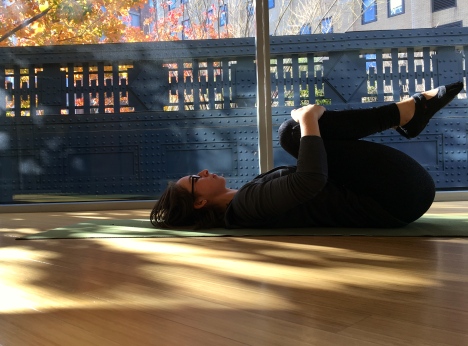
Bring your knees into your chest and give your shins a gentle squeeze. Hold this stretch comfortably for 5-15 slow deep breaths.
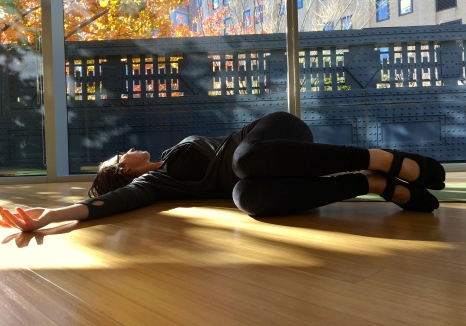
Allow your knees to go over to the right while opening your arms to either side and turning your head to the left. Breath in the twist for 5-15 breaths and then twist the knees over to the left and repeat on the other side. Twisting gently can be beneficial for getting the digestive tract moving. To modify place a pillow or block between your knees to put less of a stretch on your lower back. This is also a good stretch for the neck, shoulders, spine, and hips.
This next series should be taken as a slow moving sequence. Start on your hands and knees. On your inhale, look up towards the ceiling allowing your abdomen to stretch and open. On your exhale, thread an arm underneath your chest and come to lay on your shoulder. Pause in the stretch and breath for 2-4 slow deep breaths. On your next inhale come back to your hands and knees, and look up towards the ceiling. Exhale and thread the other arm underneath. To modify, put a large pillow or yoga block under your head. In addition to aiding digestion, this is also a pleasant stretch for the neck, shoulders, spine and hips.
And last, but not least, take a walk! Walk slowly after a big meal to help get the food moving and ease any post meal discomfort.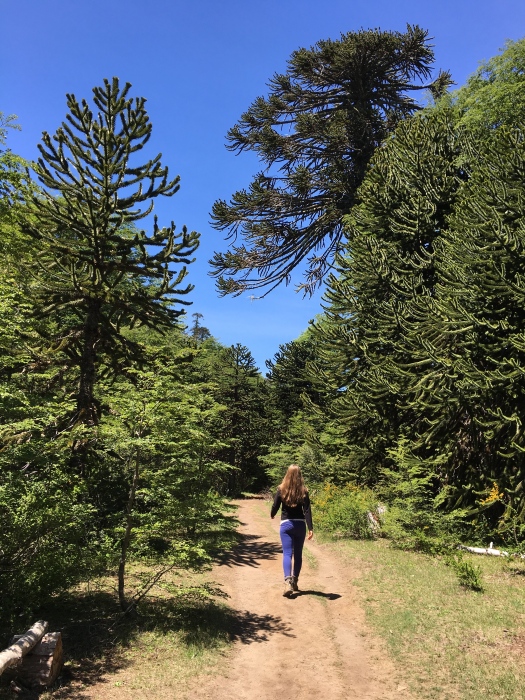 Morgana Tessler is a Certified Orthopedic Personal Trainer, Yoga, Pilates, Meditation and Barre Instructor based in NYC. Morgana offers private and group fitness sessions. For more information visit www.morgana.nyc Facebook, Instagram
Morgana Tessler is a Certified Orthopedic Personal Trainer, Yoga, Pilates, Meditation and Barre Instructor based in NYC. Morgana offers private and group fitness sessions. For more information visit www.morgana.nyc Facebook, Instagram
Good Posture in 8 Moves a Day
Posture is one of the most important aspects of physical health and overall attractiveness, but for some reason it is often overlooked. This short, simple series, requiring little to no equipment was created by Morgana Mellett, a Personal Trainer, Yoga, Pilates, and Barre instructor based in NYC for the recently published health and wellness book, THRIVE. This series will help you focus on each part of your body to improve posture and awareness. Do the series as often as possible, aiming for once a day.
Equipment:
- Mat
- Chair
- Countertop to hold onto
- Yoga strap or belt (optional)
- Yoga block (optional)
- Attire: Comfortable clothing that you can move in. All exercises are intended to be performed barefoot.
Relaxation Pose
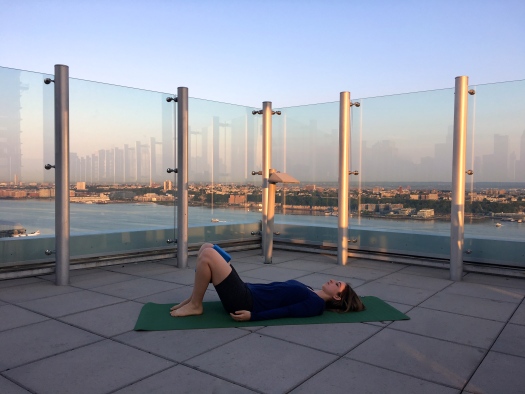
Benefits: By placing the spine and pelvis in a relaxed, neutral position and allowing your breathing to deepen, you encourage your body to relax and release patterns of tension and poor posture. The relaxation pose cleans the slate in preparation for developing postural awareness.
Set-up: Rest on a mat facing up with knees bent, feet on the mat (parallel and hip-width distance apart), and arms resting comfortably by your side.
Movement: Allow the eyes to become heavy and/or closed. Focus on your breath moving slowly in and out of your body. Scan your body for places of tension or discomfort. Send your breath into these areas, exhaling the tension out of the body.
Modifications: If the knees want to collapse inwards, place a yoga block between the thighs to keep them parallel and hip-width distance apart. Rest your hands comfortably on your chest or abdomen if preferred.
Repetitions: Remain in the pose for at least 1 minute, and try to work toward holding the pose for 5 to 10 minutes.
Neck strengthener
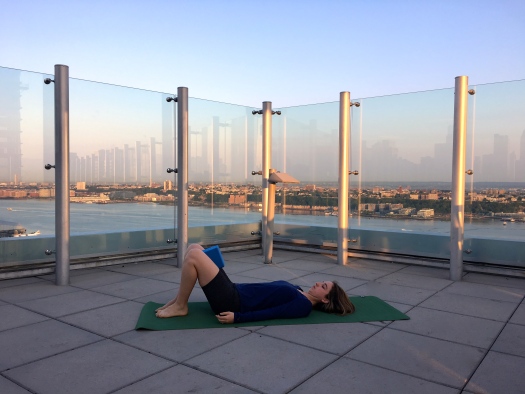
Benefits: This exercise strengthens the muscles of the neck and addresses your tendency to stick the chin forward when you are texting, eating, washing dishes or engaged in other daily activities.
Set-up: Rest on the mat facing up with knees bent, feet on the mat (parallel and hip-width distance apart), and arms comfortably by your side.
Movement: Press the back of your head into the floor slightly, tucking in your chin. Feel the muscles in the front of your neck engage. Keeping your chin slightly tucked, lift your head off the floor only enough to slip a piece of paper under the back of your head. Do not try to lift your head high; the goal is for your head to barely hover above the floor.
Repetitions: 10 repetitions for 5 seconds each. Gradually build up to 10 seconds.
Abdominals/Plank

Benefits: This exercise strengthens and engages the deepest abdominal muscles for improved postural and lower back support.
Set-up: Lie on floor facing down, propped up on your forearms.
Movement: Tuck your toes, pull your belly button into your spine, and keep it engaged throughout the exercise. Press into your forearms, and lift your body off the floor into a straight plank position. Engage the muscles of your core, thighs, and glutes, and press into your forearms. Check that your hips are in line with your head and have not gone upward or sagged to the the floor.
Modifications: To make this position less challenging keep your knees on the ground. Add a block between the thighs to help engage the pelvic floor and inner thigh muscles.
Repetitions: Hold the plank position for 10 seconds, rest, and repeat 6 times. Eventually build up to holding the plank position for a full minute.
Glute Bridges
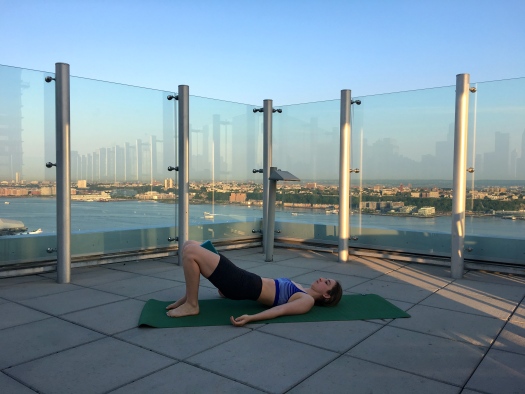
Benefits: This exercise strengthens the muscles in the back of your hips and thighs that support standing, walking, and other physical activities.
Set-up: Rest on the floor facing up with your knees bent, feet on the floor (parallel and hip-width distance apart), arms by your side, and your palms pressed gently into the floor.
Movement: Pull your belly button in, and press your lower back into the mat. Engage your buttocks and inner thighs. Lift your hips a few inches off the floor, continuing to engage the muscles of the glutes, hamstrings, inner thighs and abdominals. Do not press your hips all the way up, if you do, you will not engage the targeted muscles. Roll down through the spine, lengthening out the lower back until you return to a relaxed spine position.
Modifications: Place a block between your thighs to keep your feet and legs parallel and hip-width distance apart. To make the exercise more challenging, reach one foot forward without shifting or tilting.
Repetitions: Repeat 10 times, holding for 5 seconds at the top, and rolling slowly and smoothly through the spine to go up and down.
Back Extension
Benefits: This exercise strengthens the upper back and reverses the forward rounding posture common to everyday activities.
Set-up: Lie on your chest, bring your legs together, and extend your arms out to the side with your palms facing down.
Movement: Pull your bellybutton up and into your spine and keep it there to protect your lower back. Press your hands into the floor, and lift your face, neck, and upper back slightly off the floor. Lift your hands off the floor. Focus on engaging your upper middle back, and keeping your abdominals engaged. Keep the chin tucked so that your neck is in line with your spine.
Modifications: If this bothers your lower back, try pulling your belly button in more deeply and open the legs slightly apart. To make the exercise more challenging, add holding a light weight in both hands.
Repetitions: Hold position for 4 seconds. Repeat 10 times.
Shoulders/Chest Opener
Benefits: This exercise strengthens the muscles of the upper back and opens the chest, reverses the forward rounding posture common to everyday activities, and opens the front of the shoulders and chest.
Set-up: Stand or sit with feet slightly wider than hip-width distance apart, and clasp your hands behind your back.
Movement: Roll your shoulders up and back. Press your shoulder-blades together and down your back until you feel the front of your chest opening.
Modifications: Join your palms together if you can. If your shoulders are tight and this is not possible, interlace your fingers, or use a yoga strap.
Repetitions: Hold the position for 10 seconds. Repeat 5 times or throughout the day.
Squats
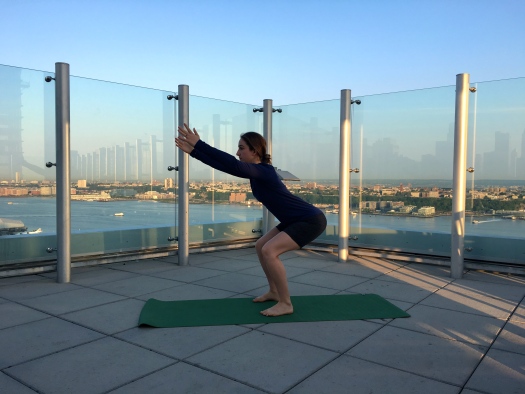
Benefits: This exercise strengthens the muscles responsible for healthy sitting and standing postures.
Set-up: Sit on a chair with hips, knees and feet flexed at a 90-degree angle. Be sure you can comfortably sit with your feet planted on the floor. Your feet should be parallel and hip-width distance apart.
Movement: Lean forward by folding at the hips. Look ahead and slightly upwards, keeping your spine flat. Pull your belly button into your spine, and press your feet into the ground to come up into a standing position. Go through the same movements in reverse to sit back down on the chair. Make sure your knees are tracking over your toes and you are pressing into your feet, engaging the thighs, glutes, and abdominals, and maintaining a straight, neutral spine.
Modifications: If the movement is difficult, reach your arms forward, or use a solid object (e.g., a countertop) to facilitate the movement.
Repetitions: Repeat slowly for 10 times, and mindfully go through these same motions any time you sit down or stand up from the seated position.
Feet Rocks
Benefits: This exercise strengthens your feet and ankles and facilitates healthier postural alignment.
Set-up: Stand with your feet parallel and hip-width distance apart, hold onto a countertop.
Movement: Pull your belly button into your spine, open up your chest, and gently engage your upper middle back. Check to see that your neck is in line with your spine and that your gaze is directly forward. Rock back and forth, shifting your weight backward onto your heels with your toes lifted, then forward onto the balls of your feet with your heels lifted.
Modifications: Make the rocking motion smaller or bigger, depending on what feels more comfortable to you.
Repetitions: Repeat 10 times, back and forth.
This series was originally published in THRIVE: An environmentally conscious lifestyle guide to better health and true wealth by K. Chayne
Morgana Tessler is a Certified Orthopedic Personal Trainer, Yoga, Pilates, Meditation and Barre Instructor based in NYC. Morgana offers private and group fitness sessions. For more information visit www.morgana.nyc Facebook, Instagram
Outdoor Spring Workout
As the weather turns warmer and the days become longer it is the perfect time to get outside for a workout. No need for the gym or any equipment, this full body workout makes use of your bodyweight and what you’re likely to find in your neighborhood park.
Join Personal Trainer Morgana in this fun outdoor workout!
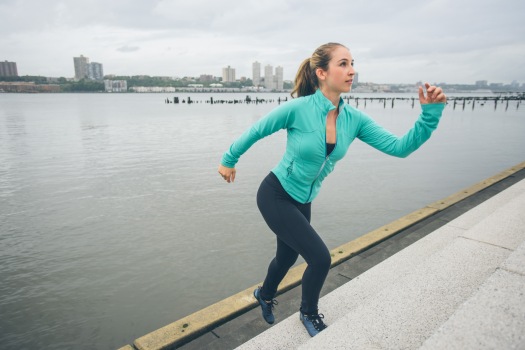
Running up the Stairs: As a warm-up begin by walking briskly up and down a set of stairs. Build the walk up into a fast walk or run.
Squats: A great way to strengthen and tone your glutes and thighs. Starting from a wide parallel stance, bend your knees and send your hips back behind you. Keep your back flat and check that your knees have not gone past your feet. To come up push into your feet and tighten your abs and glutes at the top.
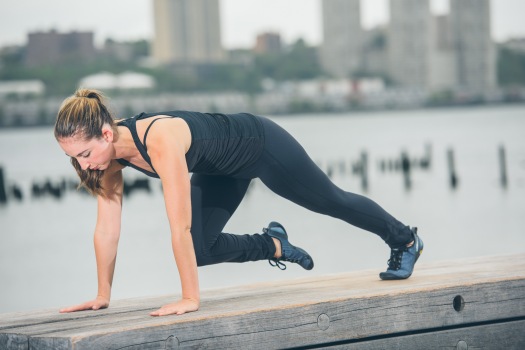
Mountain Climbers: A great exercise for strengthening your core and upper body as well as increasing your heart rate. Starting in a plank position alternate bringing your knees into your chest. To make it more challenging hop your feet in and out one at a time.
Lunge/Balance: Standing with your feet parallel and hip distance apart, bring one knee up and find a balance, hold for a few seconds. Step your lifted leg back into a low lunge. In your lunge lower your back knee so it is parallel with the ground, check that the front knee has not gone past your toes. Pull your abs in and keep your upper body lifted. From the lunge move back up into the balance position.
Tricep Dips: Find a bench and place your palms on the bench pointing towards your body. With either bent or straight knees bend and straighten your elbows squeezing into the back of your arms at the top. Try lifting one leg to make it extra hard!
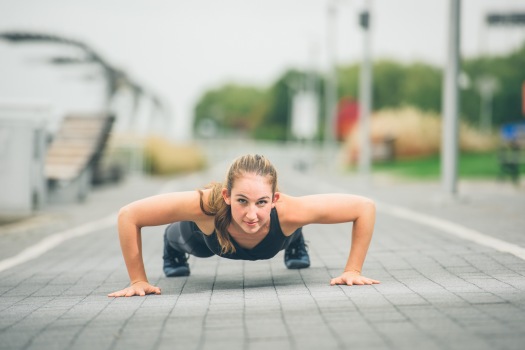
Push-ups: The ultimate core and upper body workout. Starting in a plank with your hands wider than shoulder distance, keep your hips slightly lifted, knees tight, and abs pulled in. Lower towards the ground keeping the correct alignment.
Morgana Tessler is a Certified Orthopedic Personal Trainer, Yoga, Pilates, Meditation and Barre Instructor based in NYC. Morgana offers private and group fitness sessions. For more information visit www.morgana.nyc Facebook, Instagram
